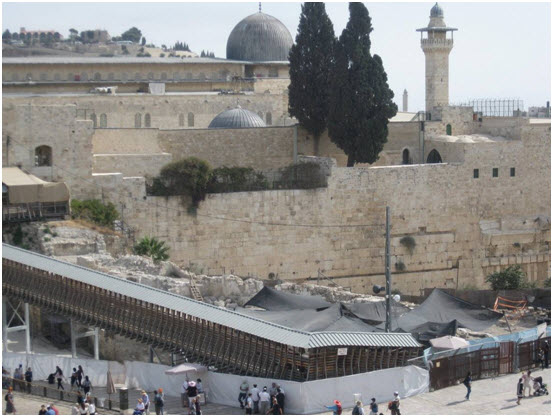According to a new report issued by Emek Shaveh, double standards are the norm in the archaeology of occupied East Jerusalem. For example, the extreme-right settler Elad Foundation has a hold over the subterranean layers in the Davidson Center – situated in the open-air park opened in the area south of the Mughrabi ramp in 2001 – and along the Western Wall, but the Palestinian residents of the Muslim Quarter do not have any say over the ground underneath the floors of their private homes.
The Davidson Center is a joint project which was first established by the East Jerusalem Development Company and the Israel Antiquities Authority (IAA), with funds donated by a Jewish “philanthropist” from overseas. Yet its operation soon became a bone of contention between two Israeli government-owned companies, the Company for the Reconstruction and Development of the Jewish Quarter (JQDC) and the East Jerusalem Development Company to whom the former company had leased it. Eventually, when an agreement to transfer management of the Archeological Park and the Davidson Center to the extremist right-wing Elad organization was publicized and then discussed in court, the Israel Antiquities Authority’s (IAA) voice was not heard in public. This silence simply aided Elad’s cause.
In the realm of archaeology in Jerusalem, theoretical statements about objectivity and scientific truth are meaningless because in fact the activities of the IAA in East Jerusalem are promoting the agenda of extreme-right organizations.
For example, during the excavations in the open-air park in which the Davidson Center is situated, remains of structures were discovered from the early Islamic period (the 7th and 8th centuries CE) and from the Roman and Byzantine periods (7th – 1st century CE), and a few remains from the Hellenistic and earlier periods (2nd – 8th century BCE). However, in its display of the finds from the excavations, the Davidson Center highlights those from the Second Temple Period (particularly the 1st century CE) – a street, shops, traces of the destruction of the city by the Romans. At the visitor’s center, one can watch a film that simulates the experience of a Jewish pilgrim who ascends the Temple Mount in order to buy a sheep for sacrifice. A computerized model offers the visitor an opportunity to walk through the area of the Temple Mount during the Second Temple period.
Thus we see that the cooperation between the Israel Antiquities Authority and the settlers’ foundations, first and foremost among them the Elad Foundation, is granting a one-sided chauvinist narrative legitimacy even at the Davidson Center. Moreover, this cooperation strengthens the Elad Foundation in the process of taking over sites of historic and archaeological significance in Jerusalem’s historic basin and allows it to edge closer to the most sensitive site in the area – the Temple Mount, as well as to the most important site for the Jewish people – the Western Wall.
“In our opinion it is important that the Davidson Center, like all the other archaeological sites in Jerusalem, exhibit the beautiful remains that were discovered in this city – through all its periods and from all cultures,” Emek Shaveh writes in its report.



